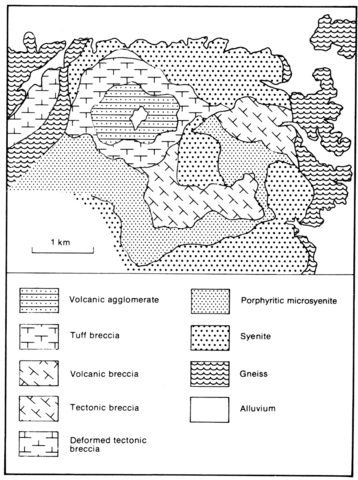stripes
These form an east-west-trending group of major intrusions, volcanic vents, necks and dykes intrusive into Precambrian gneisses and granites. The two principal intrusions are Marapicu and Mendanha, which are separated by a narrow zone of gneiss and consist principally of various types of syenite, nepheline syenite and phonolite. Necks of alkaline tuffs and breccias include blocks of phonolite, trachyte, lamprophyre and syenite, together with abundant dykes of trachyte, bostonite and phonolite. A complex volcanic centre at the eastern end of Mendanha, Nova Iguaca, (Fig. 2_209) has been mapped in detail by Klein and Vieira (1980) and includes volcanic agglomerates, tuffs and breccias cutting syenites; ignimbrites also emanated from this centre (Klein et al. 1984).
AMARAL, G., BUSHEE, J., CORDANI, U.G., KAWASHITA, K. and REYNOLDS, J.H. 1967. Potassium-argon ages of alkaline rocks from southern Brazil. Geochimica et Cosmochimica Acta, 31: 117-42.
KLEIN, V.C. and VIEIRA, A.C. 1980. Vulcoes no Rio de Janeiro breva geologia e perspectivas. Mineracao e Metalurgia, 419: 44-6.
KLEIN, V.C., VALENCA, J.G. and VIEIRA, A.C. 1984. Ignimbritos do vulcao de Nova Iguacu e de "Chamine do Lamego", Rio de Janeiro. Anais Congresso Brasileiro de Geologia, 33: 4346-54.
LIMA, P.R.A. dos S. 1976. Geologia dos macicos alcalinos do estado do Rio de Janeiro. Semana de Estudos Geologicos, Itaguai: 205-59


